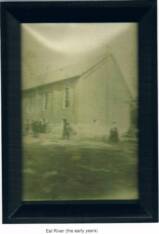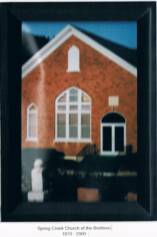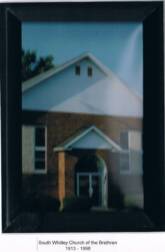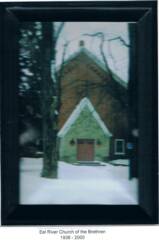The Eel River Congregation began with a few Brethren families, who migrated from Southern Ohio, and settled along the Eel River, near what is now North Manchester, Ind. In 1836, Joseph Harter, his son Eli, and their families, were the first to move from Montgomery County, Ohio, and make their homes along the river. Others soon followed and by 1838 they organized the Eel River Church of the Brethren. The early Brethren enjoyed meeting in homes and often built them with moveable walls to accommodate seating large groups. Within the next decade, their numbers had grown and meeting in homes was more difficult. Travel was also challenging; which meant getting to a church meeting took a great deal of time.
With these factors in mind, in 1852, the territory of the Eel River Church was divided into North and South, with the boundary being the Wabash/Kosciusko County line. The South Territory was to be known as the Manchester Church. Soon a log meeting house was built east of North Manchester, only to be replaced in 1858 by a larger building on the West side of town. In 1873, a portion of the Manchester territory was separated for the formation of Ogan’s Creek Church. In 1932, the congregation asked to be disorganized. By 1881 a second meeting house was built within the town of North Manchester. For 30 years, the congregation had two meeting houses.
From 1708, through the next 160 years, the Brethren resisted official recognition with an official name. However, under some pressure in 1871, Annual Conference decided the official name to be German Baptist Brethren. By 1908, following the two splits in 1881-82, Annual Conference decided the official name was to be The Church of the Brethren.
In 1911, the two meeting houses in the South Territory became two congregations; the West Manchester Church of the Brethren, located west of town; and the Manchester Church of the Brethren, located in town.
In the North Territory, the Eel River Church had three meeting houses. The Middle House was built in 1860, the East House was built in 1868 and the West House was also built in 1868. In every case the congregations reluctantly gave up the intimate fellowship which came with meeting in homes; but the growth was rapid and additional locations also made for shorter distances to travel. In 1870, another division of the Eel River Territory took place; but rather than starting a fourth Eel River Meeting House in the North Territory, approval was given to form the Spring Creek Territory.
In 1913, Brethren living in South Whitley, some of whom traveled to Spring Creek for worship, were given approval for formation of the South Whitley Church of the Brethren. This new congregation included people who were members of Sugar Creek, Pleasant View and Spring Creek churches. By this time, seven separate congregations had been formed from the original Eel River Territory. (Eel River, West Eel River, Manchester, West Manchester, Ogan’s Creek, Plunge Creek, and Spring Creek)
In 1881, all of the congregations felt the impact of some of their members leaving to become a part of “The Old Order Movement” (German Baptist Brethren). The following year, another split took place, with the “Progressive Movement” (Ashland, Ohio Brethren) attracting more people who chose to leave Church of the Brethren congregations.
In 1913 the Eel River Church changed again. The West Meeting House was organized into a separate congregation, West Eel River Church of the Brethren. The East Meeting House became the Plunge Creek (Liberty Mills) Church of the Brethren. The Middle Meeting House was to be known as the Eel River Church of the Brethren.
The next 85 years were full of life, for these seven churches; with periods of growth and decline, professional pastors, empowerment, renewal, service and missions. By the mid-1990s, they were all feeling the effects of significant cultural changes that had taken place during 1950-1980s. People were now more likely to shop for a church which fit their needs. Travel had become much easier and many people were driving past a close Church of the Brethren, in order to find a better fit. Territories were no longer relevant. Programming offered by various churches became important criteria in selecting a church, especially among families with young children. Many popular programs required large numbers of people to make them most effective. These factors, and others, meant that some churches became smaller and a few became quite large.
With an understanding of these cultural changes, congregational leaders, within the original Eel River Territory, began to have conversations about mergers. With the assistance of South/Central Indiana District Ministers, several exploratory meetings were held to discuss benefits and problems related to church mergers. The result was that some congregations which had been together a hundred years earlier, decided to merge together again.
First, South Whitley and Spring Creek congregations officially merged in 1998 and were known as “South-Creek Church of the Brethren”. In 2000, Eel River and South-Creek congregations merged and became known as Eel River Community Church of the Brethren. In 2007, the West Manchester Church of the Brethren merged with Eel River Community Church of the Brethren, retaining the name of Eel River Community Church of the Brethren. Three of the original seven congregations, plus South Whitley, are now merged into one, and are meeting at the Eel River Meeting house, built in 1860.







